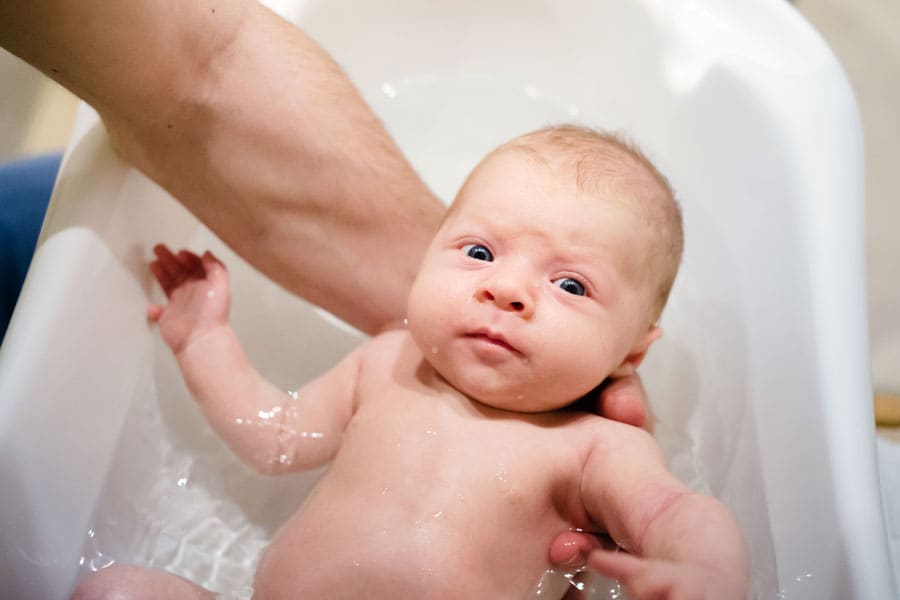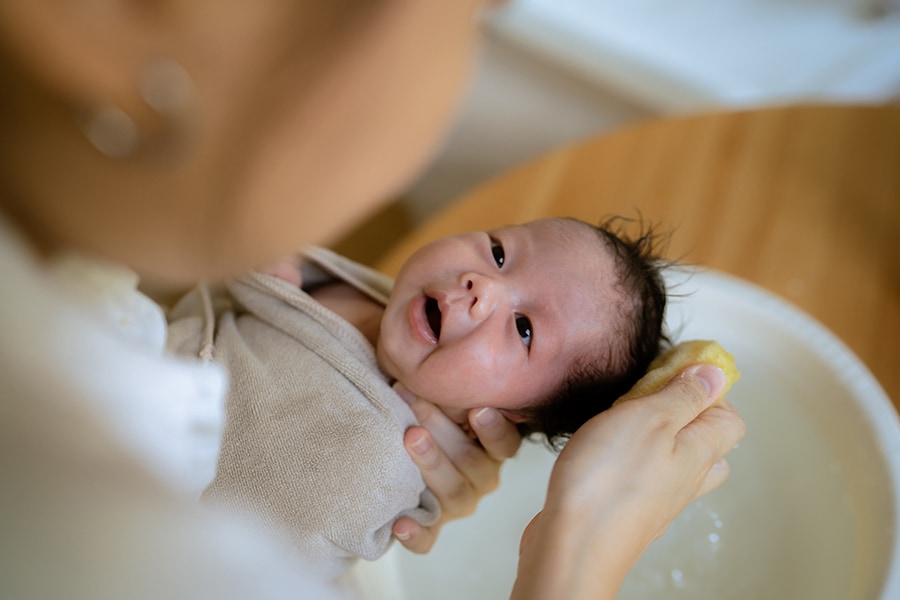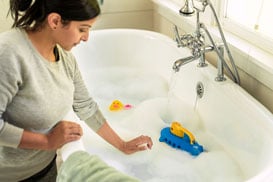Baby Bath Safety and Tips for Bathing Baby
For many new parents and caregivers, bathing your baby can be a special bonding experience, and it continues to be a fun time for little ones into the toddler years.
Having fun in the tub is certainly important, but keep bath safety in mind, too. Unfortunately, drowning is a leading cause of death in children under 4, and drowning is often quick and silent. It can happen in as little as 30 seconds in just 1 inch of water.
Below, our Children’s Healthcare of Atlanta pediatric experts answer your most common baby bath safety questions to keep bath time safe, fun and simple.
In this article:

Baby bath safety tips
From your baby’s first sink or tub bath on, it’s important to practice bath safety.
The most important thing to remember about baby bath safety is close supervision. Our top tip? When bathing, keep your hand on your baby at all times, no matter what.
More baby bath safety tips:
- Gather any towels, shampoo and other supplies before you start your baby’s bath. This way, there’s no reason to leave your baby’s side while they’re in the bath.
- Once the water is running, don’t leave your child’s side. Drowning is often silent and can happen in as little as 30 seconds, and in only 1 inch of water. Keep a hand (and your eyes) on your child, or stay within arm’s reach, during bath time.
- Avoid using bath seats for babies. These seats are designed to support babies so they can sit up in the tub. This may give a false sense of security about leaving an infant unattended. However, these seats can easily tip over. Instead, use a baby bathtub or a sling insert in the sink or tub if it makes bath time easier. None of these devices are a substitute for supervision. Never leave your baby unattended if there is water in the tub.
- Run a shallow bath. We recommend using no more than about 2 inches of water. Even though it doesn’t seem like a lot of water, children can drown in just 30 seconds, in as little as 1 inch of water.
- Test the bath temperature. Use your wrist or elbow to make sure bathwater is warm, not hot. To be extra careful, set your water heater thermostat to 120°F.
- Drain water immediately after each bath.
Bath safety can be simple. The bottom line: The most effective bath safety tool on the market is you! You’re always your baby’s best lifeguard.
When to start bathing your baby
You can start bathing your baby as soon as you want, but remember not to get their umbilical cord stump wet until it has fallen off. Start with sponge baths. Once the umbilical stump falls off, you are ready to put your baby in the water.
Once the umbilical cord stump falls off, we recommend getting into a routine of bathing your baby before bed, so bath time becomes a symbol of wind-down time.

How often should you bathe a newborn?
Although it’s up to you how often to give your baby a bath, Strong4Life experts suggest you bathe a newborn 1 to 2 times per week.
As they grow, their bath routine will probably change. But babies only need bathing about 3 times per week, or every other day, at most.
Why shouldn’t I be bathing my baby daily?
Because babies don’t sweat or get dirty like older kids and grown-ups, they just don’t need baths as often as we do. Their skin is very sensitive—bathing babies daily can cause dryness and irritation.


How to sponge bathe a newborn
Before your baby is ready for baths in the sink or a tub, give them sponge baths. A sponge bath is like a normal bath, but you don’t put your baby in the water.
How to sponge bathe a newborn:
- Gather your bath supplies. It’s important to have your bath supplies ready to go so you can keep a hand on your baby at all times for close supervision.
You'll need: - A bowl of plain, lukewarm water
- A damp washcloth (no soap)
- A dry towel or blanket
- Clean, dry pajamas or clothes
- Make sure your baby is warm. Because your baby will be naked for their bath, make sure the room is a comfortable temperature (around 75°F) and try to keep your baby wrapped in a blanket or thick towel during the bath.
- Lay your baby down. Find a flat, comfortable surface for your baby to lay on. Remember to always keep a hand on your baby, especially if the surface is above the ground.
- Start by cleaning your baby’s face. Use your damp washcloth to gently wipe your baby’s face, including their eyes and ears. Starting at their nose, softly swipe out to the corner of their eye. Clean the outside folds of their ears, but do not use cotton swabs inside their ear.
- Dip your washcloth into plain, lukewarm water if it gets dry, and continue bathing your baby from the neck down. Uncover one area at a time to keep your baby warm, and rinse with a clean washcloth or small cup of warm water.
- Be careful not to get the umbilical cord stump wet. Follow any cord care directions from your pediatrician.
- Contact your pediatrician for bathing guidelines after circumcision. Proper care depends on a variety of factors, such as the instrument used.
Your baby will most likely cry during their first few baths, and that’s OK. It’s normal for them to cry as they adjust to a new experience, and there are a few ways you can respond to crying. But once they get used to them, most babies find baths soothing and comforting.
If your child has an injury or is showing signs of illness, call your doctor or visit an urgent care center. If your child has a life-threatening injury or illness, is having trouble breathing or is unconscious, call 911 and/or visit an emergency department immediately.




